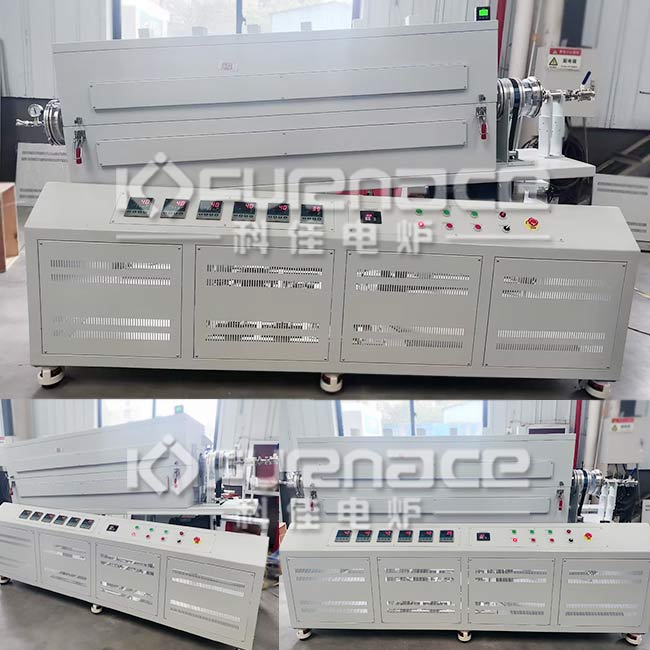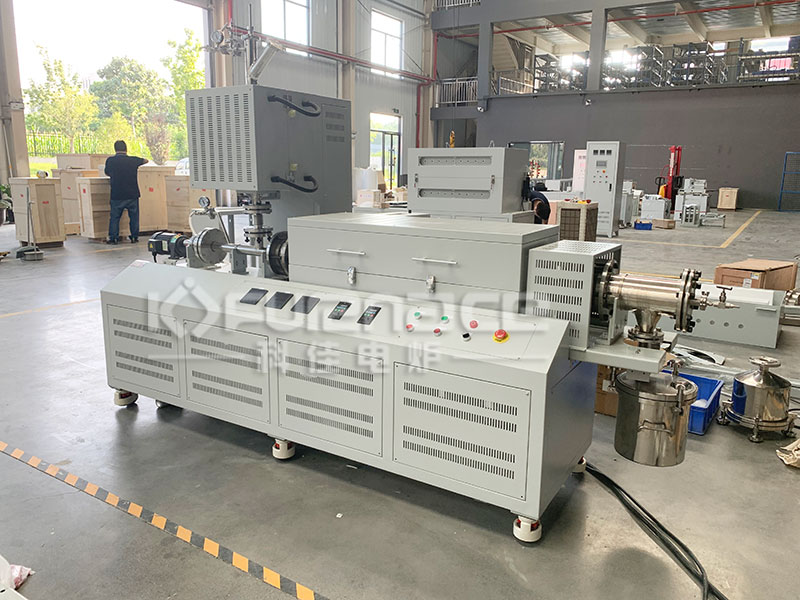Tel Number
181-3719-5600
The rotating tilted tube high-temperature furnace is a high-temperature heat treatment equipment that integrates rotating and tilting functions, widely used in fields such as materials science, metallurgy, ceramics, chemical engineering, and new energy. Let’s take a detailed look at this device below!

High temperature rotary furnace that can be used to calcine powders (click on the image to view product detail)
1. Structural principle
The rotary tilting tube high-temperature furnace usually consists of a furnace body, a heating system, a rotary tilting mechanism, a vacuum and atmosphere control system, and a temperature control system:
Furnace body: Adopting a double-layer furnace shell structure, the inner layer is a high-purity alumina polycrystalline fiber furnace, the outer layer is a metal shell, and the middle is integrated with an air cooling system to achieve rapid temperature rise and fall and surface temperature control.
Heating system: equipped with heating elements such as silicon carbon rods, silicon molybdenum rods, or resistance wires, which generate heat through current and raise the temperature inside the furnace through radiation and heat conduction. The maximum working temperature can reach 1800 ℃.
Rotating tilting mechanism: The furnace body can rotate and tilt around a certain axis through a motor and transmission device. The rotation function ensures that the material is uniformly heated during the heating process, avoiding local overheating or clumping; The inclined design facilitates the entry and exit of materials, especially suitable for continuous feeding or segmented reaction process requirements.
Vacuum and atmosphere control system: Using mechanical pumps and molecular pumps to remove air from the furnace, creating a vacuum environment that reduces or avoids reactions between materials and gases such as oxygen in the air. At the same time, specific gases such as hydrogen, nitrogen, argon, etc. can be injected into the furnace according to process requirements to create specific atmospheric conditions.
Temperature control system: integrating artificial intelligence PID regulation technology and microcomputer intelligent control, supporting multi-stage program temperature control, with a constant temperature accuracy of ± 1 ℃, ensuring that the temperature inside the furnace is stably maintained within the set range.
2. Performance advantages
The rotating inclined tube high-temperature furnace has the following advantages:
Accurate temperature control: adopting good temperature control technology, high temperature control accuracy, ensuring the accuracy and stability of experimental conditions.
Uniform heating of materials: The rotating function keeps the materials rolling during the heating process, avoiding local overheating or agglomeration, and improving the consistency of heat treatment effect.
Easy to operate: equipped with a touch screen and PLC control system, supports one click tilt/rotation, and can observe the material status in real time (some models have a lid that can be opened).
Safe and reliable: equipped with tilt interlock, over temperature power-off, leakage protection and other safety devices to ensure the safety of the experimental process.
Wide applicability: It can handle powder and granular materials, such as battery positive and negative electrode materials, catalyst carriers, etc. It is also suitable for bulk materials, boat loaded samples, such as semiconductor wafers, ceramic substrates, etc.
Energy saving and environmental protection: Adopting energy-saving ceramic fiber materials and double-layer structure to reduce energy consumption and minimize thermal radiation to the external environment.
3. Application scenarios
The rotating inclined tube high-temperature furnace has a wide range of applications in the following fields:
Metallurgical industry: used in the smelting, sintering, and heat treatment processes of metal materials to improve their performance and quality.
Ceramic industry: used in the firing and glaze treatment processes of ceramic products to improve the density and surface quality of ceramics.
Glass industry: used in the melting, annealing and other processes of glass products to improve the transparency and strength of glass.
Chemical industry: used in the synthesis and reaction processes of polymer materials to promote chemical reactions and improve product yields.
In the field of new energy, in the preparation of positive and negative electrode materials for lithium batteries, uniform mixing and reaction of materials are achieved through the rotation and tilting function, which improves battery performance.
Materials science research: used to explore the performance changes and reaction mechanisms of materials under high temperature environments, providing strong support for the development of new materials.

Customized rotary tube furnace with preheating (click on the image to view product details)
4. Operating standards
To ensure the safe operation of the rotating inclined tube high-temperature furnace and the accuracy of experimental results, the following operating procedures must be followed:
Equipment inspection:
Check for cracks, deformations, or other damages in the furnace body to ensure its structural integrity.
Check if the heating element is intact to avoid temperature runaway caused by damage to the heating element.
Check if the cooling system, gas supply system, and electrical system are functioning properly, ensuring that all connecting components are securely fastened.
Experimental preparation:
Choose appropriate experimental materials and tools to ensure that the materials can withstand high temperatures and avoid chemical reactions or physical changes during the heating process.
Prepare necessary protective equipment, such as heat-resistant gloves, protective goggles, and protective clothing, to cope with emergencies.
Design a temperature rise and fall curve, with a heating rate not exceeding 10 ℃/minute and a cooling rate below 15 ℃/minute.
Gas management:
Ensure that the gas supply system is well sealed to prevent gas leakage.
Select appropriate protective gases such as nitrogen, argon, etc. according to experimental requirements, and ensure that the gas purity and flow rate meet the requirements.
When introducing gas, the flow rate should be slowly adjusted to avoid a sudden increase in furnace pressure due to excessive gas flow.
Heating process:
Set an appropriate temperature range according to experimental requirements and ensure that the temperature control system can be accurately adjusted.
During the heating process, temperature changes should be monitored in real-time to avoid temperatures that are too high or too low. Excessive temperature may cause material melting or damage to the furnace body, while excessively low temperature may affect experimental results.
To ensure the accuracy of temperature control, it is recommended to use multiple temperature sensors for multi-point monitoring and regularly calibrate the temperature sensors.
Cooling treatment:
Turn off the heating power and stop heating.
Choose the appropriate cooling method according to the experimental requirements, such as natural cooling or forced cooling.
During the cooling process, protective gas should continue to be introduced to prevent the material from oxidizing during the cooling process.
Monitor temperature changes inside the furnace to ensure moderate cooling rate.
Emergency Management:
Develop detailed emergency plans and conduct regular drills.
The operator must be familiar with the location of the emergency stop button on the equipment and be able to quickly cut off the power and gas sources in case of emergencies.
Operators must master basic first aid knowledge, such as burn treatment, gas poisoning first aid, etc.
The laboratory should be equipped with necessary first aid equipment, such as fire extinguishers, first aid kits, etc., to cope with emergencies.Click to learn more tube furnaces! Or click on online customer service to learn more about product information!
Contact Information
E-mail:
